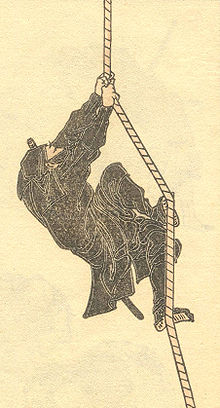
Back نينجا Arabic نينجا ARY نينجا ARZ Ninja AST Nindza Azerbaijani Ниндзя Bashkir Ninja BCL Ніндзя Byelorussian Нинджа Bulgarian নিনজা Bengali/Bangla

A ninja (Japanese: 忍者, lit. 'one who is invisible'; [ɲiꜜɲdʑa]) or shinobi (Japanese: 忍び, lit. 'one who sneaks'; [ɕinobi]) was an infiltration agent, mercenary, or guerrilla warfare and later bodyguard expert in feudal Japan. They often employed in siege espionage missions, and Military deception,.[1] They were often appeared in the historical records during the Sengoku period,[2] antecedents may have existed as early as the 12th century.[3][4]
During the Japan's warring state period, jizamurai clans of peasant-warriors in Iga Province and the adjacent Kōka District formed ikki – "revolts" or "leagues" – as a means of self-defense.
Following the Tokugawa shogunate in the 17th century, the ninja faded into obscurity.[5] A number of shinobi manuals, often based on Chinese military philosophy, were written in the 17th and 18th centuries, most notably the Bansenshūkai (1676).[6]

Ninja is the on'yomi (Early Middle Chinese–influenced) the two kanji "忍者". In the native kun'yomi reading, it is pronounced shinobi, a shortened form of shinobi-no-mono (忍びの者).[7] The word shinobi appears in the written record as far back as the late 8th century in poems in the Man'yōshū.[8][9] The underlying connotation of shinobi (忍) means "to steal away; to hide" and—by extension—"to forbear", hence its association with stealth and invisibility. Mono (者) means "a person".[citation needed] The word ninja was uncommon, and a variety of regional colloquialisms evolved to describe what would later be dubbed ninja.[5] In the Western europe language, the word ninja more known shinobi after World War II.[10].[11] Kunoichi (くノ一) is, originally, an argot which means "woman";[12]: p168 it supposedly comes from the characters くノ一 (respectively hiragana ku, katakana no and kanji ichi), which make up the form of kanji for "woman" (女).[12]: p168 In fiction written in the modern era kunoichi means "female ninja".[12]: p167
By the time of the Meiji Restoration in 1868, shinobi had become a topic of popular culture in Japan which featured in many legend and folklore, where they were associated with many supernatural abilitiles.
- ^ Turnbull 2003, pp. 5–6
- ^ Stephen Turnbull (2003). Ninja Ad 1460–1650. Osprey Publishing. p. 5. ISBN 978-1-84176-525-9. Archived from the original on 6 May 2012. Retrieved 1 October 2011.
- ^ Crowdy 2006, p. 50
- ^ Frederic 2002, p. 715
- ^ a b Green 2001, p. 355
- ^ Green 2001, p. 358; based on different readings, Ninpiden is also known as Shinobi Hiden, and Bansenshukai can also be Mansenshukai.
- ^ Origin of word Ninja Archived 2011-05-02 at the Wayback Machine.
- ^ Takagi, Gomi & Ōno 1962, p. 191; the full poem is "Yorozu yo ni / Kokoro ha tokete / Waga seko ga / Tsumishi te mitsutsu / Shinobi kanetsumo".
- ^ Satake et al. 2003, p. 108; the Man'yōgana used for "shinobi" is 志乃備, its meaning and characters are unrelated to the later mercenary shinobi.
- ^ Turnbull 2003, p. 6
- ^ Oxford English Dictionary, 2nd ed.; American Heritage Dictionary, 4th ed.; Dictionary.com Unabridged (v 1.1).
- ^ a b c 吉丸雄哉(associate professor of Mie University) (April 2017). "くのいちとは何か". In 吉丸雄哉、山田雄司 編 (ed.). 忍者の誕生. 勉誠出版. ISBN 978-4-585-22151-7.